How To Create An Effective Social Media Strategy
What's a Social Media Marketing Strategy?
A social media marketing strategy is a guide that helps you stay on track during the planning and execution stages of your social media marketing.
A soc ial media marketing strategy is a guide that helps you stay on track during the planning and execution stages of your social media marketing.
Social media has come a long way in the past ten years, and in 2021, there's so much high-quality, engaging content that it can leave marketers wondering "How will we stand out?"
Competing on social media means developing a consistent flow of engaging content that provides variety while building trust and consistency with its audience.
That's where your social media strategy comes in.
What is a social media strategy?
A social media strategy is a guide t hat defines your overall purpose and intentions. It's used to guide the day-to-day planning and execution of all your social media publishing and marketing.
Think of a social media strategy as a roadmap that drives all your other planning, decision-making, creativity, production, and publishing.

By the time you finish writing your social strategy, you'll have a blueprint for success that isn't dependent on the latest trends and features.
What's the difference between a social media strategy and a social media plan?
The terms "strategy" and "planning" often get mixed up, so let's clear up any confusion before we get started.
During the strategy phase, you make decisions and document your choices on essential social media marketing objectives.
Social media strategy objectives:
- Set goals and key performance indicators
- Define your target audience
- Develop content guidelines
- Determine the purpose of each social media platform, as it relates to your brand
Planning happens after you've created your strategy.
During the social media planning stage, you work out the details of how you'll execute the strategy.
Social Media planning objectives:
- Develop social media campaigns
- Develop advertising campaigns
- Create a content calendar
- Delegate tasks to your team
- Determine when and where to publish content
In this article, we're going to show you how to create a social media strategy — the important first-step you need to be successful on social media.

Why is a social media strategy important?
Your social media strategy is a roadmap that guides your social media planning and activities. It helps you stay on track with your original intentions.
If it seems like creating a strategy is too big an investment of your resources, consider this:
90% of people who use the internet are on social media.
In 2021, more than half the world (55%) is now on social media — that's 4.33 billion people, and an overwhelming number of them interact with brands regularly.
- 36 percent of Instagram users in the United States use the platform to follow brands .
- 35% of Twitter users, 24% of Pinterest users, and 19% of Facebook users log on specifically to follow brands.
- Brand-owned content received 290 billion actions (reactions, comments, shares, retweets, and likes) across Instagram (67%), Facebook (23%), and Twitter (10%) in 2020.
- One billion users spend an average 30 minutes a day on Instagram, and 50% of them have visited a website to make a purchase after seeing a product or service**.
With bigger audiences comes more competition, so to reach users, you've got to capture their attention, earn their trust, and form a connection. A social media strategy helps you achieve all three of those objectives, plus:
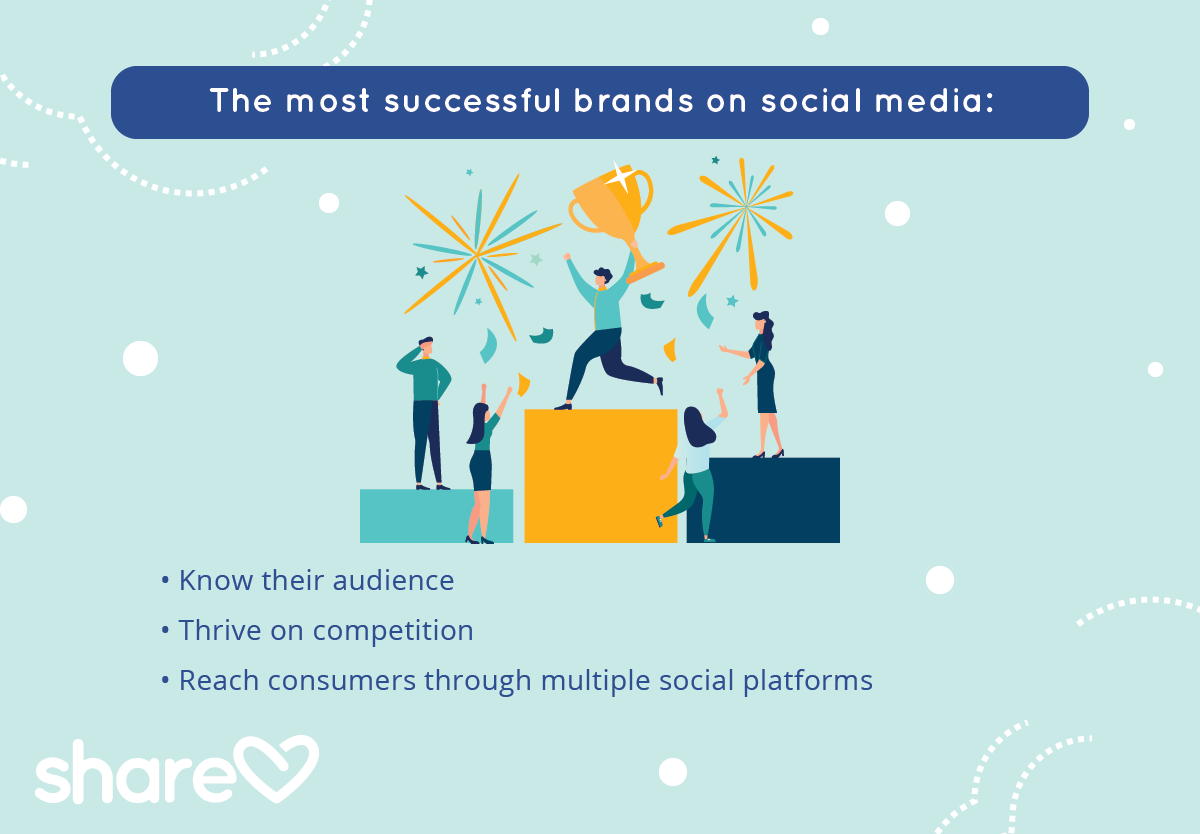
A report by Audience Bloom content marketing agency found that the most successful brands on social media have a handful of traits in comm on, three of which begin with your social media strategy.
The most successful brands on social media:
- Know their audience
- Thrive on competition
- Reach consumers through multiple social platforms
We cover all three of these traits in the steps below, giving you a n even greater cha nce of success.
Step 1: Establish Your Social Media Goals
In this step, you'll make a list of social media goals that align with your overall business goals.
Why are you investing time and money into social media marketing?
You might be tempted to congratulate your team and celebrate as you watch your follower counts grow.
But, more followers don't always equal more profits.
And let's face it, selling more products is why brands invest their time and money into social media in the first place.

How are you going to use social media in a way that ultimately increases revenue for your business?
The top social media goals brands focus on in 2021:
- Engagement
- Audience growth
- Brand awareness
- On-platform sales
- Leads and conversions
- Sales
- Customer service
- Increased web traffic
- Leads and conversions
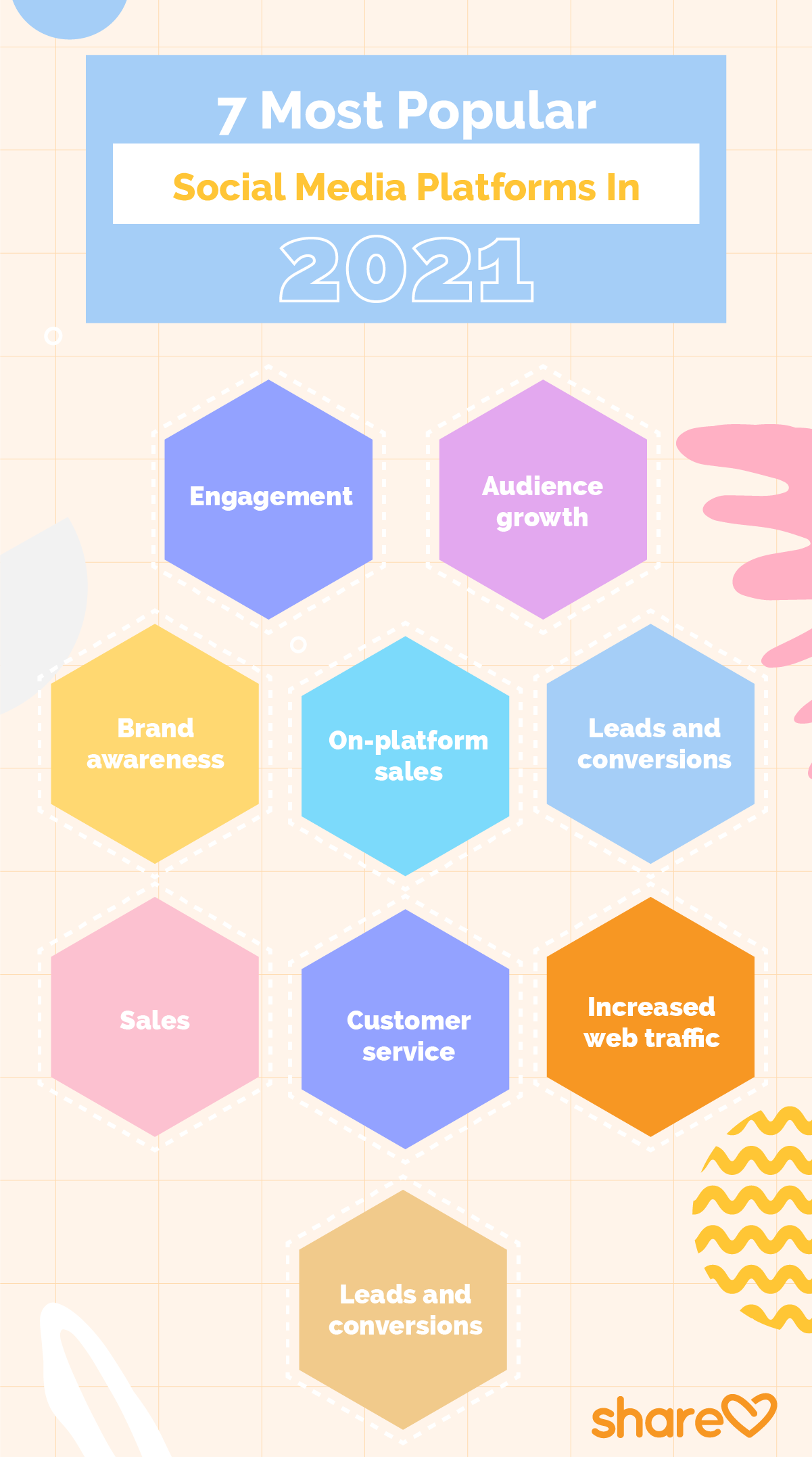
In addition to the objective listed above, 2021 brings two unique challenges that require many marketers to add one more thing to their list.
- Follow up on your social cause promises.
In 2020, many brands stepped forward to support causes such as Black Lives Matter, LGBTQ support, and many other human rights issues.
Many companies added social cause taglines or graphics to their websites, or incorporated human rights issues into their corporate or social policies.
If your company used social justice issues to connect with its audience in 2020, then 2021 is the time to follow through on what you promised or declared.
To avoid public relations nightmares and cement the trust between you and your audience, set social media goals that follow up on what you started.
Whether you participate in fundraising, legislation, volunteering, contributions, changes to the way you do business, special training — whatever it is — it's critical for brands who promised or declared alliance to social causes to follow through with actions that support their claims.
"…companies and brands will need to continue their promise towards inclusion and cultural competency efforts," — "Many statements were released, but the key for brands looking to solidify their relationship with consumers is how they follow through with continued action . – Tara Miremadi, digital brand manager at health and fitness marketing agency Margaux Agency
2. Build on customer loyalty and retention if you had an influx of business in 2020.
Many brands picked up an influx of new customers during the pandemic. If your brands experienced significant growth in 2020, you'll want to include "customer retention" at the top of your list of goals.
Consumers switched brands during the pandemic months to accommodate for different lifestyles.
However, with life slowly moving back to "normal," you'll need to get creative to keep the influx of new customers.
For example, brands that provided better delivery but offered higher-priced items or less selection might need to rethink their approach to retain business moving forward.
3. Build first-party data.
In 2020, marketers may be facing a cookie-free world and new privacy regulations in California.
According to Harry Muagans, CEO of consumer privacy service Privacy Bee , marketers should get comfortable with new data collection practices because brands will need to build their own infrastructure to comply with upcoming regulations.
"The coming year will provide a final chance for marketers to educate themselves about the impact of the cookie-less future and to prepare for it,"
"The most important action involves improving access to, and effective use of, their valuable first-party data—and ensure agencies have a clear plan for placing and measuring campaigns after the change." – Harry Muagans, CEO Privacy Bee, via Wordstream
What Social Media Best Helps Marketers Achieve
A 2021 industry report by Social Media Examiner reveals what more than 4,300 marketers say social media helped them achieve:
- 88% say social media increased their brand exposure
- 79% say social media increased traffic to their websites
- 69% say social media generated leads
- 61% say social media helped them develop loyal fans
Setting goals helps to guide the rest of your social media strategy and, eventually, your social media planning. If you can narrow your focus to one goal, or a small number of goals, you're much more likely to enjoy success.
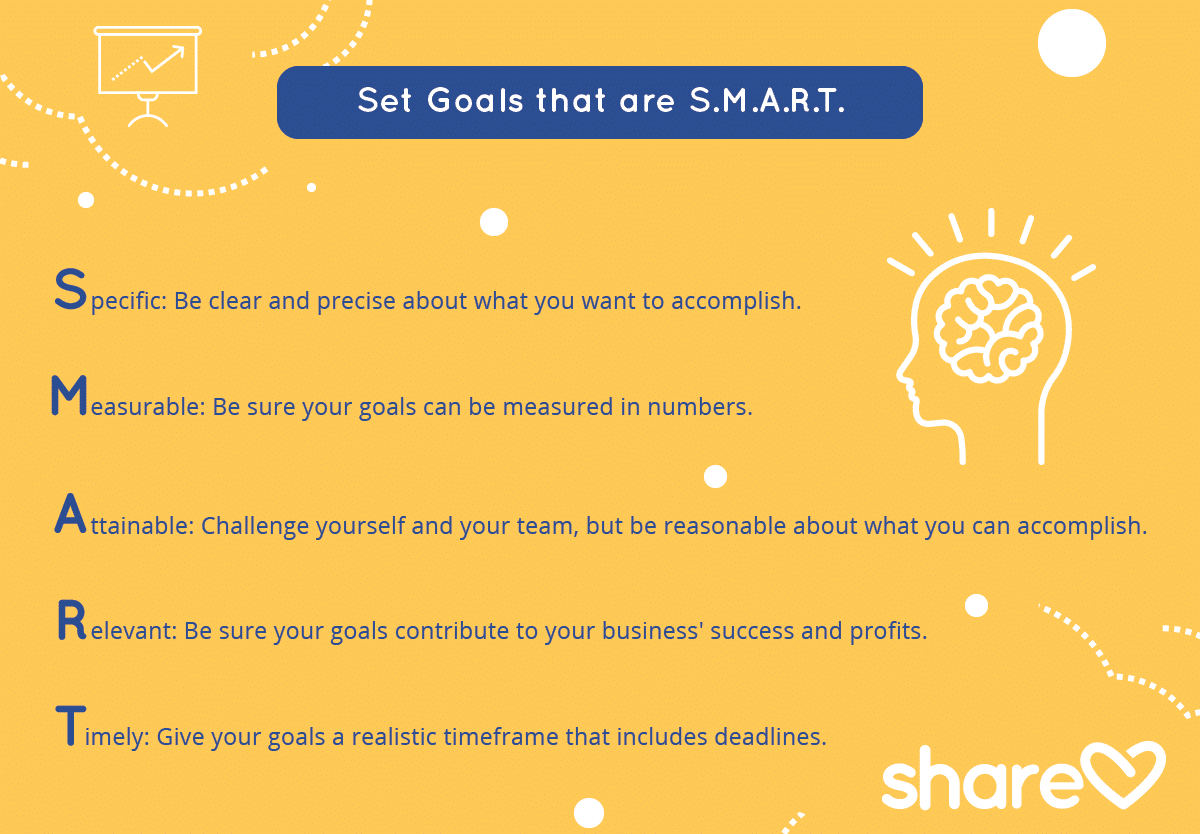
Before you choose goals, be sure they're S.M.A.R.T!
S pecific: Be clear and precise about what you want to accomplish.
M easurable: Be sure your goals can be measured in numbers.
A ttainable: Challenge yourself and your team, but be reasonable about what you can accomplish.
R elevant: Be sure your goals align with your business in a way that contributes to the success and profit of your brand.
Timely: Give your goals a realistic timeframe that includes deadlines.
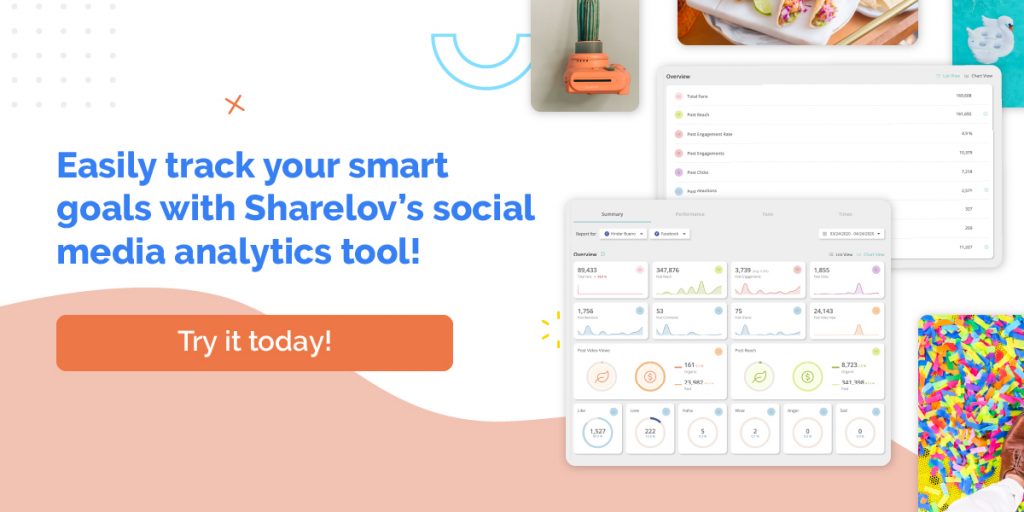
Once you've written a list of your social media goals, you're ready for step #2.
Step 2: Define Your Key Performance Indicators (KPIs)
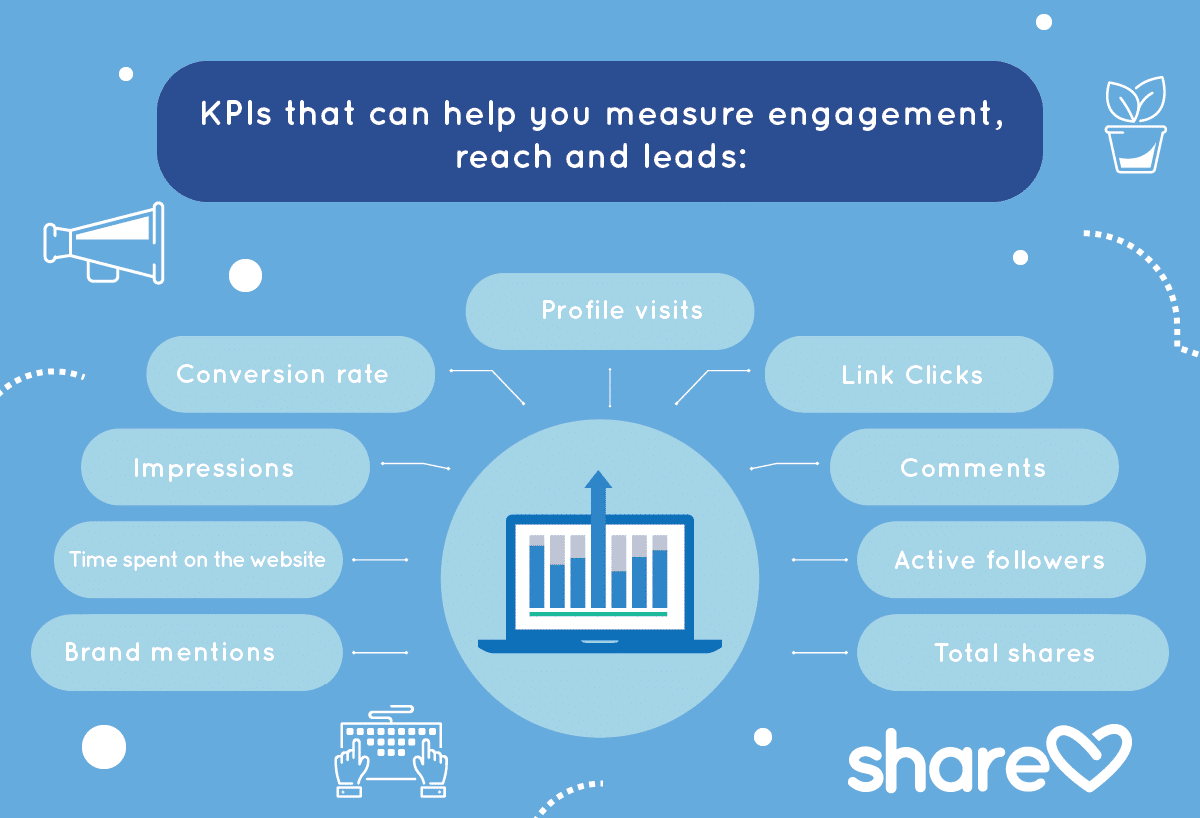
Social media marketing requires a great deal of time and effort on the part of your team. This costs money, so it's a "must" to understand how much, if any, profit your social marketing generates.
The key to tracking your success lies in step #2 of your social media strategy.
Choose your key performance indicators (KPI's).
Key performance indicators (KPIs) are an essential part of a social media marketing strategy because they help you understand how successful your campaigns and content are.

In this step of the social media strategy, you decide what metrics you'll use to define the success of your campaigns and content.
KPI's help you discover problem areas so you can take corrective action before problems get out of hand. They also help you understand what type of content is working best, so you can deliver more of what's working.

Choose the KPI's that align with the social media goals you set in step #1.
Most Common Social Media KPIs
Here are some common KPIs that can help you measure engagement, reach and ROI:
- # People Reached
- Organic vs. Paid Reach
- Sales
- Engagement rate
- Number and quality of engagements
- Shares
- Link Clicks
- Video views
- Average Watch Time (videos)
- Conversion rate
- Brand mentions
- Profile visits
- Active followers
- Time spent on the website
- Audience size (# of followers)
- Leads (email subscribers)
Following are some of the most critical KPIs used by marketers.
Engagement rate
The engagement rate of a post or the engagement rate of your overall audience lets you know how well you're connecting with your audience.
On many platforms, such as Facebook and Tiktok, engagement determines how many people will see your post.
Engagement on social media is determined by several types of data:
- Total engagements per post
- Impressions per post
- Likes or reactions per post
- Comments per post
- Shares per post
- Engagement rate on individual posts
- Average engagement per brand
- Profile visits
- Clicks
Traffic
The amount of traffic coming from your website is an excellent indicator of how well your social media campaigns are performing.
To take it a step further, you might also want to evaluate the bounce rate of the traffic coming from social media.
How long visitors stay on your website lets you know whether your campaigns are effective for reaching potential customers, or whether you're falling into the "clickbait" spiral.
Sales On Website
How much of the traffic coming to your site from social media is converting to sales?
Sales On Platform
If you're selling your products directly on social media, such as with Instagram shopping tags, your total sales are an obvious metric to follow.
Brand Mentions
Brand mentions can help you understand how well your user-generated-content is doing.
Competitor Analysis
Monitoring your competitors' social media content and their brand mentions helps you get a bigger picture of how well your brand content is performing.
By comparing their engagement rates to yours, you can understand whether you're keeping up with industry standards or falling behind.
You can easily track your competitors' social media activity on Facebook, Instagram, and TikTok with Sharelov's monitoring tools (free with your subscription).
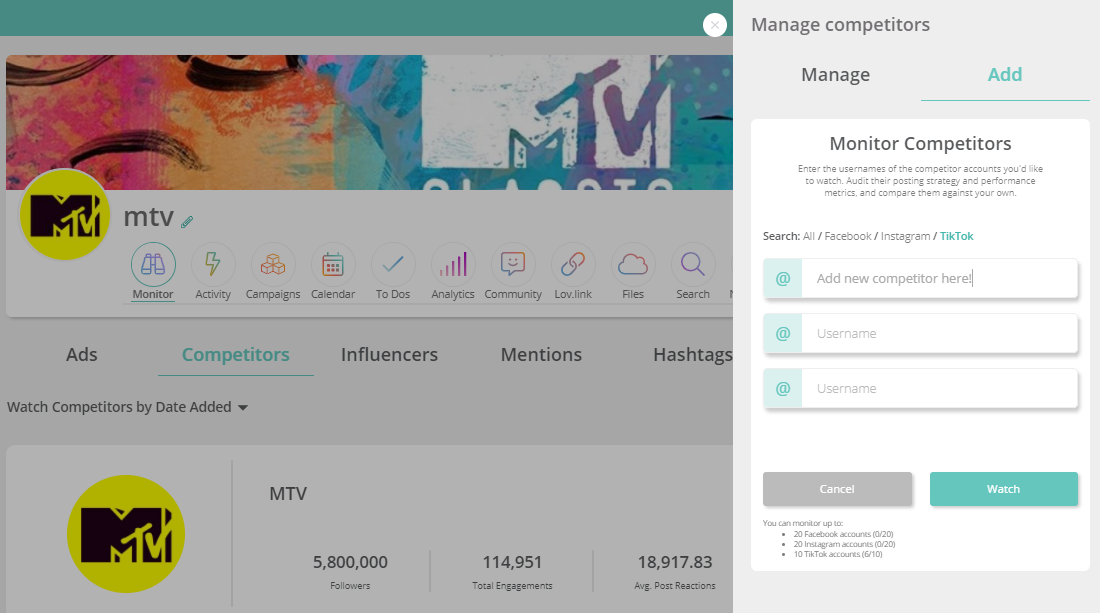
Tracking your competitors' audience size, total posts, and frequency of posting on social media can also reveal how well your brand is performing on social media.
Define Specific KPIs For Each Social Media Platform
Different social platforms have d ifferent personalities, so bra nds often interact differently on each platform.
When defining which KPIs you'll use to measure the success of each social channel, consider the following:
A. Why does your audience use this social media channel?
B. How does your audience like to engage with brands on this social media channel?
C. How can your brand engage followers and enrich their experience on this channel?
D. What KPI's can help you measure the success of your goals listed in step #1?
Make a List Of Your Top KPI's
List the key performance indicators that you'll use to measure the success of your social media marketing.
How do you measure the progress of KPI's?

Most social platforms offer free analytics or insights software for business p ages, which give you real-time feedback on all of your KPI's.
For example, Facebook shares analytics through a program called Facebook Insights, which is connected to your account. Insights is a free service that offers hundreds of real-time data points that show how customers are interacting with your brand.
The image below shows a glimpse of one screen from Facebook Insights.

Each social platform has its own analytics software, so get to know the insights section of the social channels you are active on. Then, you can track and measure your KPI's with ease.
Step 3: Research Your Audience
Find out as much as possible about your audience so you can get a head start on creating content that they're likely to engage with.
For example:
- Take a look at what types of content your audience likes to interact with .
Do they engage more with videos than photos? Do they respond to positive messages over negative ones? What inspires them to like, comment, and share other brand's content?
- What time of day is your audience online , and at what times are they most likely to interact with videos, photos, or stories?
- Are they engaging during work hours, or is your brand a part of their after-work and family hours?
This type of informatio n provides valuable clues into what kinds of content you should publish on social media.
A lot of this information will come from the social media analytics that each platform offers. If you don't have enough social media history to form helpful insights, try researching information about each channel to get started.
For example, Best Times to Post to Insta gram 2021 – For Marketers is a helpful industry report put together by our team here at Sharelov.

You'll learn what kinds of content people are most likely to engage with, and what times they're most likely to engage with brands on social media.
Plus, you'll get plenty of tips and advice for increasing your engagement rates on Instagram.

Step 4: Research Your Competitors

In this step, your goal is to conduct a competitive analysis across various social media channels to help you:
- Discover what your competitors are doing on social media
- Learn how their audiences are responding
- Find gaps in their content
- Study their advertising strategy
Did you know? You can monitor your competitors' ad campaigns on Instagram & Facebook with Sharelov's New! Monitor Ads Feature

There's a wide variety of tools and software that can help you research your social media competitors. But, a quick glance at your competitors' social pages can also give you a handful of powerful insights.
Monitoring your competitors and industry influencers gives your brand an advantage on social media. Sharelov's Monitoring Tool helps you keep tabs on your industry, your competitors, and top influencers.
Try to answer the following questions about your competitors :
- What social networks are they using?
- Which platforms drive the highest engagement rates for their brand?
- How are they using social media to increase revenue?
- What topics and content generate the most engagement from their audience?
- What tactics are not working well for them?
- What are they missing?
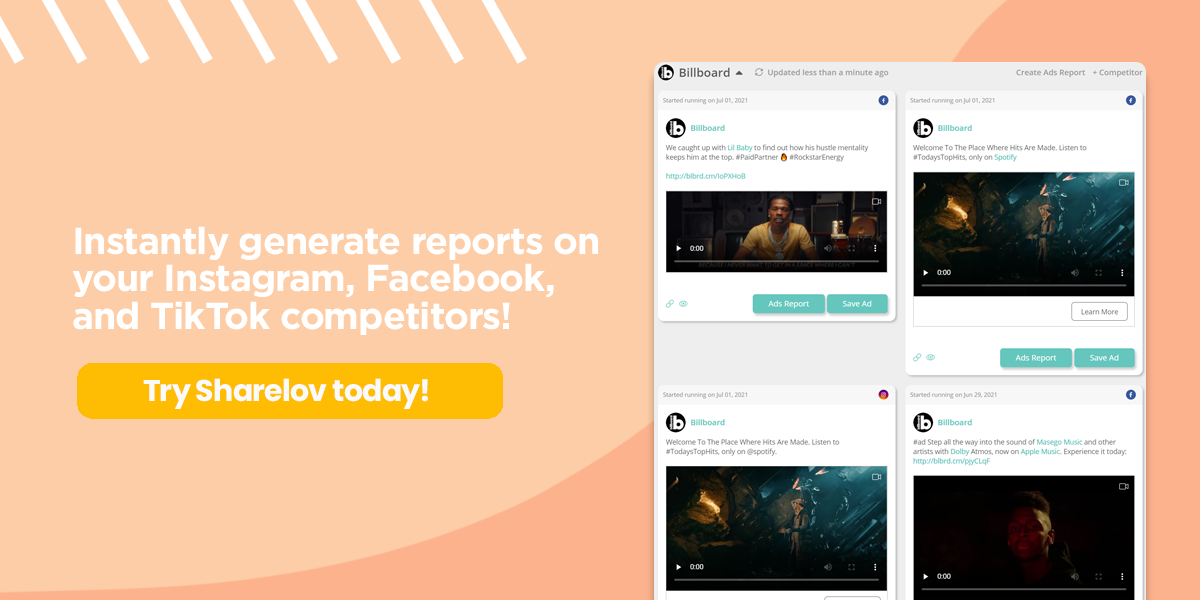
Create an instant competitive report on your competitors' posts on Fb and IG. Analyze their most engaging posts. Understand their posting strategy. Easily share with your team and clients,
Create a Competitive Analysis Chart
Create a chart for future reference that lists:
- The names of at least 2-3 competitors
- The tactics that are and aren't working for them
- The behavior traits of their audience
Document the answers to the questions above in a chart that's easy to skim and review.
Creating a competitive analysis chart for your social media strategy will help your team plan and develop better content during the planning stage.
The competitive research you've completed in this step will be helpful as you move forward in your strategic planning.
Next, you'll choose your brand's social media platforms.
Step 5: Choose Your Social Media Platforms
In this step, you'll identify which social networks your brand should use..
To choose the best social media channels for your brand, consider the following:
- Where is your audience most active?
- What platforms can help you achieve your goals?
- Which platforms are best for engaging your audience?
Each social media channel serves a specific personality type. Your communication and content will likely change from channel to channel.
Most Popular Social Media Ch annels for Marketers In 2021
Here are the six most popular social media channels for marketers in 2021, according to the Social Media Marketing Industry Report by Social Media Examiner.
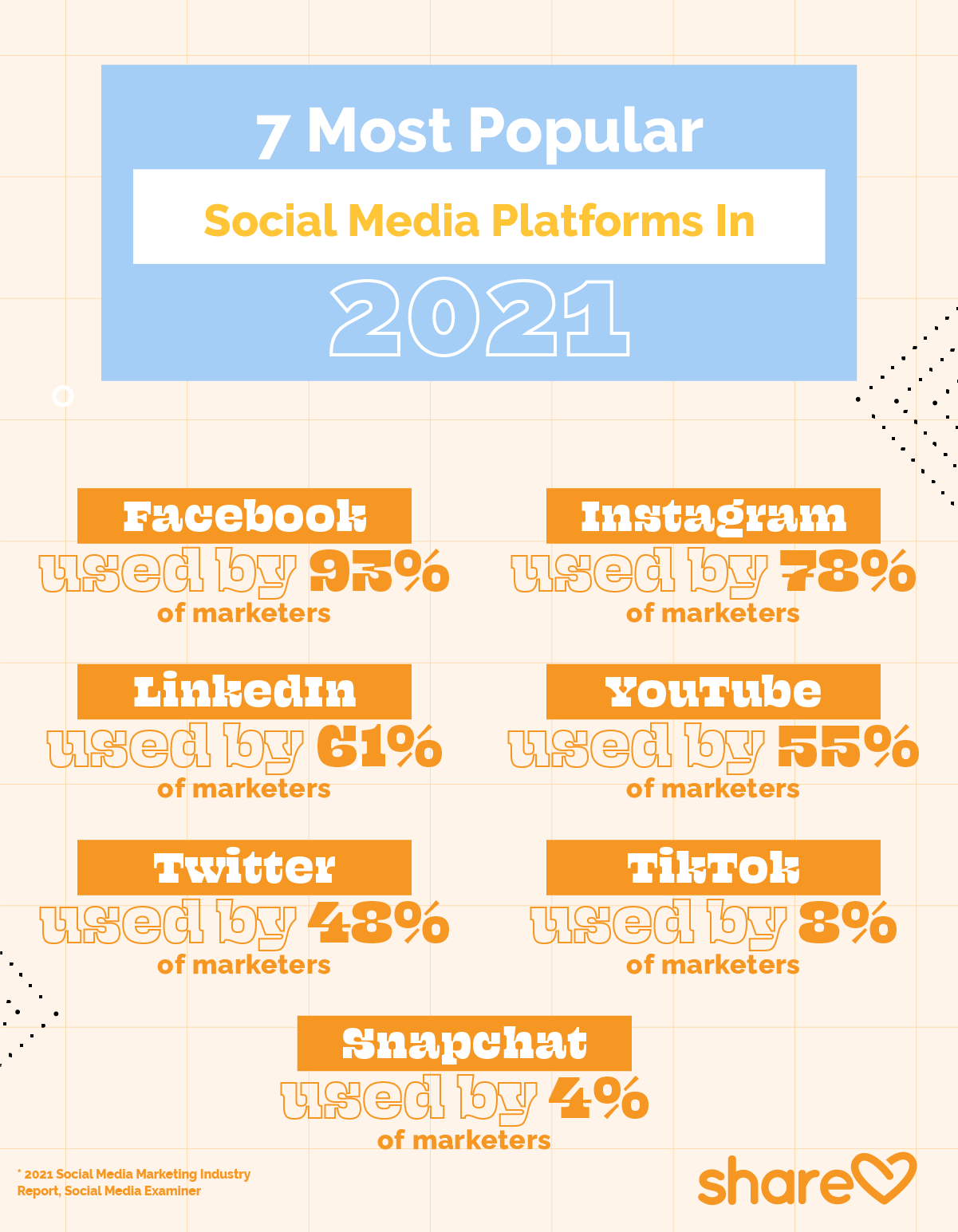
#1. Facebook – 2.85 billion active monthly users
93% of marketers use Facebook, although only 58% say that it's their top platform and just 47% intend to increase organic activities on the channel.
#2. Instagram – 1 billion + active monthly users
78% of marketers use Instagram, and 64% plan on increasing their organic activity within the next year. 90% of Instagram users follow at least one brand .
#3. LinkedIn – 756 million members
61% of marketers use LinkedIn, which has 2X the buying power of an average web audience and was listed as one of the top three most trusted networks in the U.S. by Insider Intelligence's 2020 Digital Trust Report .
#4. YouTube – 2 billion + active monthly users , used by 55% of marketers/
#5. Twitter – 186 million daily active users , used by 48% of marketers
#6. TikTok – Over one billion active monthly users , used by 10% of marketers

When prioritizing your social networks, consider which channels do the best job of reaching and engaging your target audience.
Other social media channels to consider:
- Reddit – With over 222 million active monthly users , Reddit maintains its status as "The front page of the internet," and claims its spot as one of the 20 most-visited sites on the internet. Reddit is popular with the under 50 crowd, especially among technology buffs.
- Snapchat : Home to over 280 million daily users , Snapchat ranks #1 as the most important social network for teenagers in the U.S. — An impressive 48% of internet users ages 15 – 25 use Snapchat.
- Pinterest: Pinterest is a visual inspiration network for product discovery and shopping. With more than 478 million active users, Pinterest is a first stop for shoppers looking for ideas on what to purchase or where to travel.

Prioritize Your Social Media Platforms
Most businesses won't achieve success on social media if they spread themselves too thin.
Instead of trying to win over followers on all the social platforms, prioritize your social media channels according to which platforms will help you achieve your goals.
If you're a small business working with limited resources , it's better to choose only 1 or 2 social media channels. Then, you can focus your efforts on doing an excellent job on those networks.
Step 6: Create Brand Content Guidelines

In 2021, social media users are inundated with content, news headlines, and posts from friends and businesses.
If you want to hijack their attention, you must create insanely engaging content.
Oh, and by the way, no pressure, but…
You only have about 5 seconds to tell your brand story on social media.
Your content needs to be engaging enough to make people stop scrolling their newsfeed and consider your brand's message.
We've got you covered!
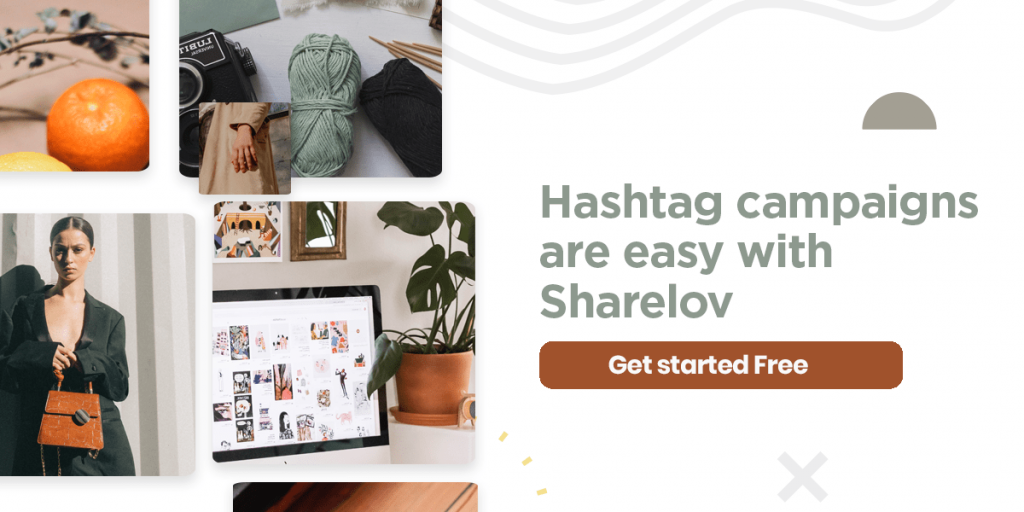
The following social media content guidelines will help your brand create consistent, relevant, and irresistible content.
CREATE A STYLE GUIDE
Begin by creating a style guide that lays out policies for how you'll communicate with your followers:
- Will your brand seeks to entertain, inform, or educate?
- Will you use humor, inspiration, or data to connect with customers?
- How will you respond to customer complaints?
- How will you handle internet trolls?
Set policies that your team can follow so that the way your brand communicates on social media is consistent in quality and style.
CREATE A CONTENT GUIDE
Next, choose the types of media you'll publish and document guidelines for each platform. Be sure to:
- Indicate how you'll tailor your content for each channel.
Each social network has a distinct personality. So, you don't want to merely re-post the same material and messaging on each platform.
Take the time to craft and optimize your captions, images, and videos for the personality of each channel. - Include instructions that ensure your content aligns with your goals and can be measured with your chosen KPI's.
- Set policies that explain how your team will determine the scheduling of your posts.
- Consider how to balance the different types of media content like articles, videos, and images.
Creating style and content guidelines helps you stay on track with goals and deliver consistent messaging that builds trust with your customers.

Once you've completed your content guidelines, you're ready to choose the tools and software that you'll use to manage your social media marketing.
Step 7: Build Your Stack

Once you have your content guidelines written, it's time to decide how you'll manage the different tasks involved in social media marketing.

Tools and software can help you manage your social media marketing more effectively. Choosing the right tools and software is important because it helps you:
- Stay organized
- Work together more easily
- Plan and schedule content in advance
- Better respond to your audience
The collection of software and tools you use is called your "stack."
In this section, you'll choose which software and tools your team will use to help you achieve your social media goals.
Here are the tools you need to manage your social media efforts:
1. Collaboration software: This tool is at the heart of all your social media efforts. It's a communications center that allows your team to share documents, images, and messages with each other.

Choose collaboration software that allows you to:
- Organize your communications by campaign, date, and groups of people in one place
- Onboard quickly.
Choose software with an easy-to-use user interface, so your team doesn't have to spend large amounts of time learning how to use it - Do your job easier and have fun while you're at it!
Additionally, it helps if your collaboration software can:
- Develop and preview multimedia content as it will look when it's published
- Assign tasks to team members
- Automatically create "to do" lists for each team member
- Record feedback and approvals on all items
- Share assets with teammates
- Suggest hashtag ideas for your posts
- Suggest best times to post for your content publishing
- Monitor other brands and top influencers
- Provide shoppable product galleries
- Display social media analytics quickly in a user-friendly interface
- Generate reports on your competitors
Sharelov has got you covered on all points!
2. Content Planning & Scheduling Software
A content calendar is an essential social media tool that helps you plan and publish your content with ease.
A social media content calendar is an essential social media tool that helps you plan and publish your content with ease.

The calendar tool should allow you to record the following information for each social platform:
- Topics to discuss
- Distribution and frequency of topics
- Date & time for posts
- Key messages
- Creative formats to develop
- Special opportunities and events to consider
This tool is a priority for your team because it helps them stay on track with goals and maintain consistency for your brand's quality, tone, and messaging across all social channels.
Be sure your content calendar allows you to publish directly from its platform! This helps you save time and spend less effort keeping your content organized.

3. Analytics software: How will you track and measure the results of your campaigns? You can use the native app included with each social channel or a more complex tool that interprets data from multiple channels.
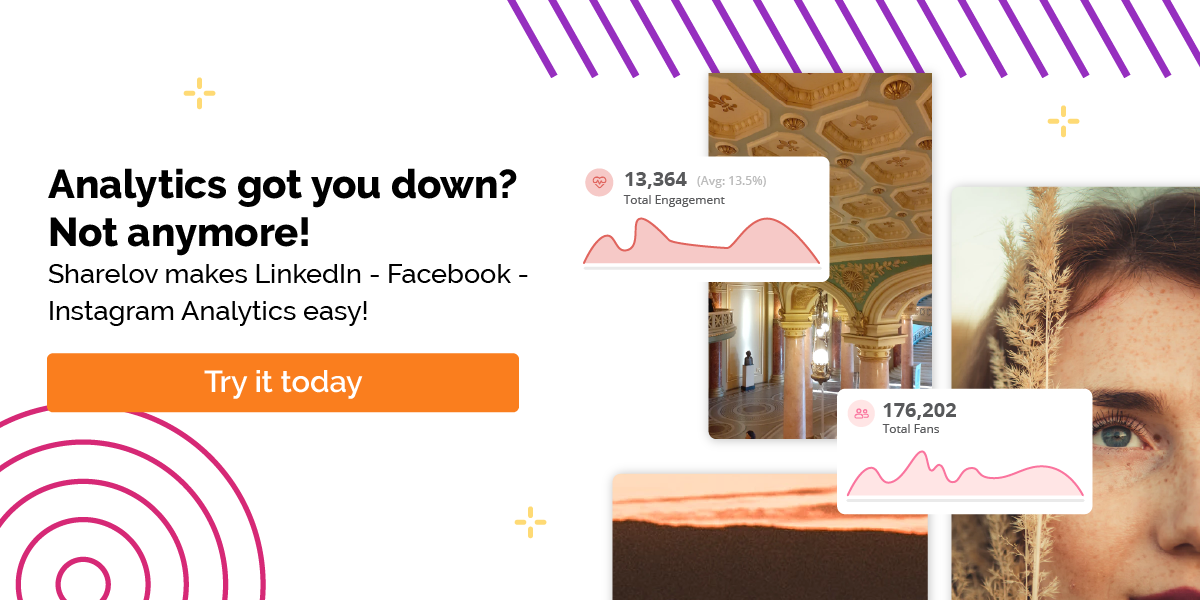
4. Social media listening tools: What software will you use to track what people are saying about your brand across social media? If you're just getting started, you can hold off on this tool until you've built an audience.

5. Customer service software : If you offer customer service on social media, consider what tool(s) can improve the quality of your customer service.
Choose the tools that you'll include in your social media stack, and write them down in your social media strategy.
Once you've chosen your tools and software, you're ready to move forward by assembling your social media team.

Step 8: Organize Your Team
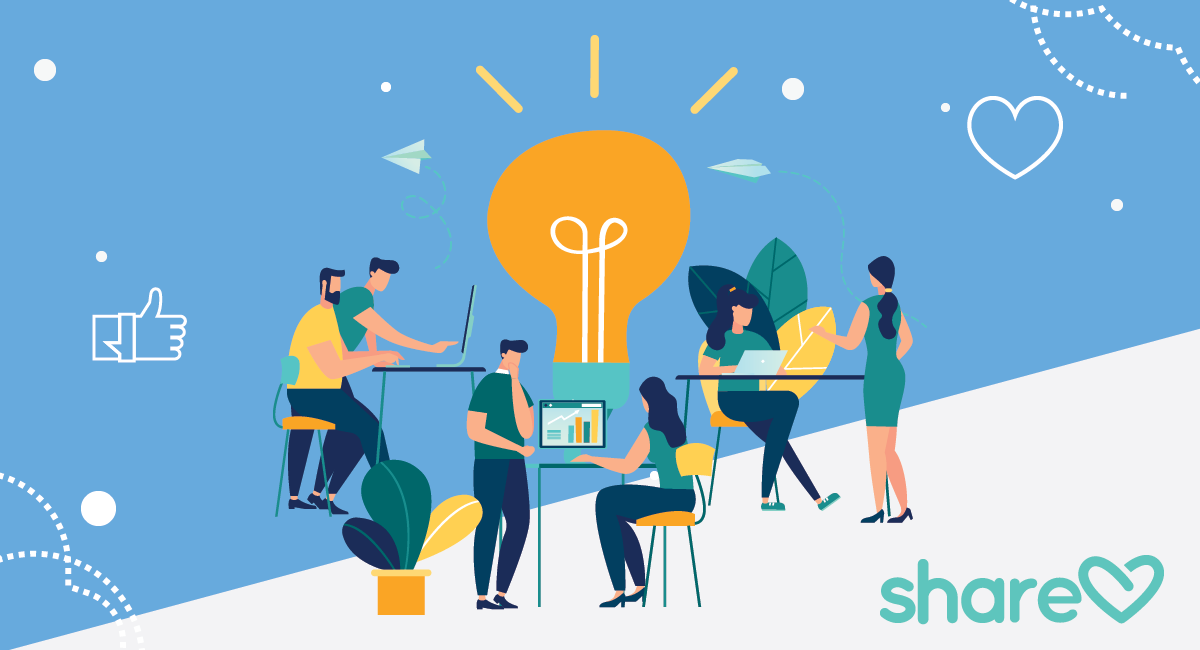
In this step, you pool your resources to create a team of people who will execute your social media strategy.
Successful social media requires an ongoing commitment of time and resources. The best way to meet these challenges is to develop a strong social media team.
Consider ways that your current employees or freelancers might be able to contribute. Here are some of the talents you'll want to pool to create your team:
- Writing
- Design
- Photography
- Illustration
- Brainstorming
- Campaign planning
- Trend-watching
- Planning and organization
Working in teams helps you produce better ideas and execute them more quickly.
In the next step, we'll take a look at how you can test, track, and optimize your social media activities.
Step 9: Test and Analyze

In this step, you'll define how your team will monitor and respond to data.
Testing is a critical step in social media marketing.
As you begin publishing content and interacting with your followers, analytics will help you understand which areas of your marketing are working better than others.
Begin by analyzing the results of your social media efforts — based on the KPIs you established in step #2.

For example,
- If data indicates that Facebook is your most cost-effective channel, then consider how you can respond to that. Perhaps you'll double your efforts on that channel.
- If the data reveals that your audience engages more with a specific video that you posted on Instagram — then think of ways to add more content that's similar.
Your social media marketing strategy needs to be responsive to the results.
To achieve great success, you need to take a bit of risk.
It's great that you get started by following examples from other brands or getting tips from industry reports.

To outrank your competitors, you'll need to do some things differently.
You want to discover which content and messaging drives the most engagement for your pages.
This requires calculated testing and experimentation.
Determine how your brand will find ways to offer unique content that's compelling to your audience, and how you'll test different approaches along the way.
Embrace Your Data
Social media platforms have made it simple and fun to check out what's happening with your content. So, there's no need to fear the data!
Adjust Your Social Strategy Along The Way.
You'll continually adjus t your strategy to keep up with the rapid changes in social media algorithms and behavior.
Identify the channels and efforts that are producing the highest ROI and adjust your strategy accordingly.
Remember to share the results and changes with your team!

A Good Social Media Strategy Gives Your Brand a Better Chance of Success
Social media algorithms and trends change constantly. So, to keep audiences engaged, marketers adjust tactics and content in response to what's working.
All these changes affect the type of content you'll publish and when you'll publish it.
Quite honestly, it can leave your head spinning.
Your social media strategy saves the day and reduces the "overwhelm" that's part of any marketer's job.
Take as much time as needed to develop your social media strategy.
It's a guide that you and your team will refer to over and over again as you navigate your way through the decisions and creative processes that make your brand a success.
Do you have any tips for writing a social media strategy? If you've written a social media strategy for your brand's social marketing, we'd love to know how it's working for you.
Please share your experience, comments, and questions below – we'd love to know how your strategy is making a difference!
With Sharelov, your team can work together faster to produce better marketing campaigns from social media to traditional.
Marketers with a documented strategy are 313% more likely to report success – Coschedule
Instagram user/brand interaction statistics- Hootsuite
How to Create an Effective Social Media Marketing Strategy [Infographic]

How To Create An Effective Social Media Strategy
Source: https://blog.sharelov.com/how-to-create-a-social-media-strategy/
Posted by: waterswittionfer93.blogspot.com


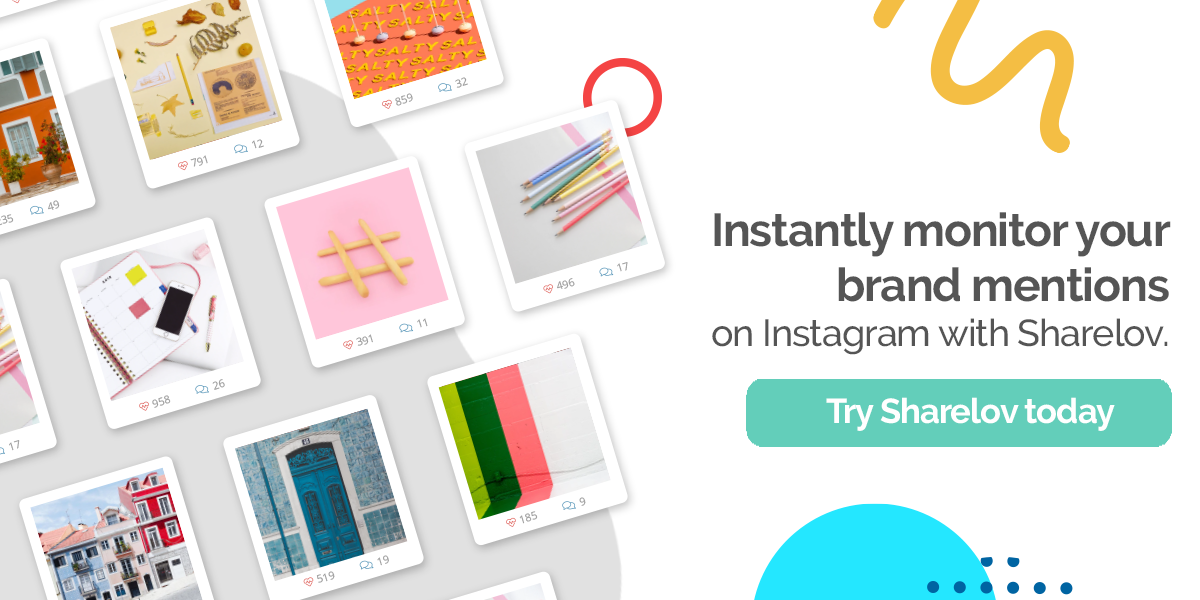
0 Response to "How To Create An Effective Social Media Strategy"
Post a Comment